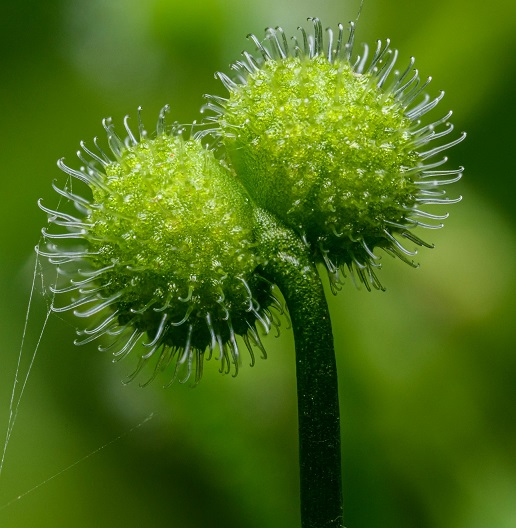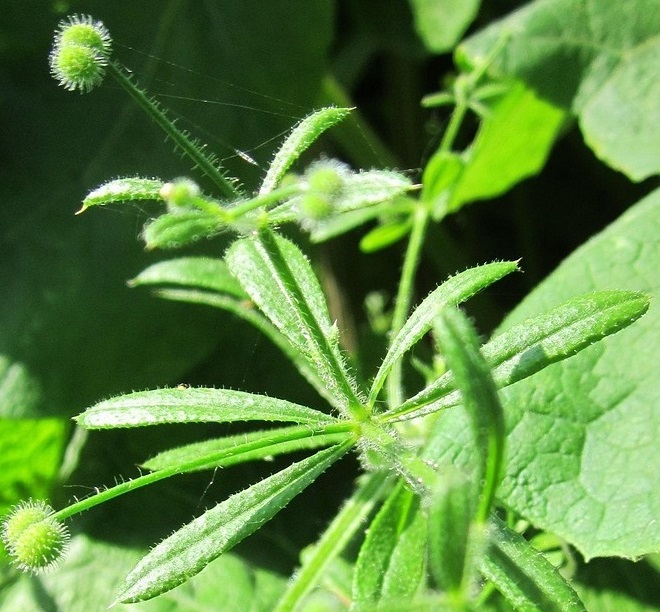

Cleavers, a brilliant green symbol of spring, proudly clings to garments, indicating a wild and adventurous lifestyle.
This widespread annual climbs and attaches to fence posts, tree trunks, and hedges with its bristly, barb-shaped hairs. This vine thrives in rainy areas, pastures, wastelands, meadows, and along roadsides. The lightweight cleaver stems are rough and hollow, yet delicious and savoury. This leggy plant produces lime-green, lance-shaped leaves that surround the stem in whorled groups of six to eight.
Its small, star-shaped blooms are made up of four white or greenish petals that rest on the fragile stems that emerge from the leaf coil. Fuzzy burred fruits appear later in the season, successfully dispersing themselves by adhering to the fur, hair, or clothes of passing animals, including people. By late April, once lush cleavers plants become stringy and yellowed, signalling the end of their active growth season.
A basket full with cleavers is a small load for the herbalist to carry. It is preferable to harvest cleavers plants at their pinnacle of lush green juiciness, right before they blossom. All herbaceous, chlorophyll-rich sections of cleavers are edible. However, the sandpapery feel of the young leaves and stems may be irritating to the tongue. These sections are more appealing when coarsely chopped in pesto or cooked into soups and other hot foods, leaving the bristles flaccid and harmless.
Therapeutic Uses
Herbalists see cleavers juice, or succus, as a valuable spring tonic. It includes mild chemicals that can activate the lymphatic system, therefore clearing oedema and other stagnation. Cleavers is recommended for premenstrual water retention, swollen breasts, post-injury swelling, and minor lymphoedema. This spring green is known for its ability to remove toxins and waste from the lymphatic system and promote blood circulation. Tincture or herbal infusions of cleavers can also help the body treat tonsillitis, ear infections, and respiratory infections. This safe lymphatic herb has gentle calming qualities and can help relieve coughs and provide expectorant assistance.
Herbalists prefer fresh cleavers for herbal formulations. A simple herbal infusion of fresh cleavers taken daily is an excellent alternative for purifying and nourishing the circulation, relieving achy or blocked joints, and treating inflammatory skin conditions. Cleavers are a mild detoxifier that helps cleanse the liver and eliminate toxins from the body. Moist cleavers have a cooling effect, making them ideal for persons who experience heat and inflammation. Because of its refrigerant properties, cleavers makes an excellent tea for any acute problem involving heat and inflammation.
As a moderate diuretic, cleavers increase urine flow and are good for soothing the delicate, inflamed tissues of the urinary system. Cleavers also provide a refreshing topical wash or wet poultice for sunburn, blisters, ulcers, and other hot spots. The plant’s juice has been used to cleanse greasy skin and treat rashes and itching disorders.
اردو میں اسے وری بوٹی یا لپیٹی بوٹی کہا جاتا ہے، موسم بہار کی ایک شاندار سبز علامت، فخر کے ساتھ کپڑوں سے چمٹی ہے، جو جنگلی اور بہادر طرز زندگی کی نشاندہی کرتی ہے۔
یہ بڑے پیمانے پر سالانہ چڑھتا ہے اور باڑ کے خطوط، درختوں کے تنوں، اور باڑوں سے جوڑتا ہے اور اپنے چمکدار، بارب کے سائز کے بالوں کے ساتھ۔ یہ بیل بارانی علاقوں، چراگاہوں، بنجر زمینوں، گھاس کے میدانوں اور سڑکوں کے کنارے پر پروان چڑھتی ہے۔ ہلکے وزن کے کلیور کے تنے کھردرے اور کھوکھلے ہوتے ہیں، پھر بھی مزیدار اور لذیذ ہوتے ہیں۔ یہ ٹانگوں والا پودا چونے کے سبز، لینس کی شکل کے پتے پیدا کرتا ہے جو تنے کے گرد چھ سے آٹھ کے گروہوں میں گھیرتا ہے۔
اس کے چھوٹے، ستارے کی شکل کے پھول چار سفید یا سبز پنکھڑیوں سے بنتے ہیں جو پتوں کے کنڈلی سے نکلنے والے نازک تنوں پر ٹکی رہتی ہیں۔ دھندلے دبے ہوئے پھل موسم کے آخر میں نمودار ہوتے ہیں، جو انسانوں سمیت گزرنے والے جانوروں کی کھال، بالوں یا کپڑوں پر کامیابی سے اپنے آپ کو منتشر کرتے ہیں۔ اپریل کے آخر تک، ایک بار سرسبز کلیورز کے پودے سخت اور پیلے رنگ کے ہو جاتے ہیں، جو ان کی فعال نشوونما کے موسم کے اختتام کا اشارہ دیتے ہیں۔
کلیورز سے بھری ٹوکری جڑی بوٹیوں کے ماہر کے لیے ایک چھوٹا بوجھ ہے۔ کلیورز کے پودوں کو پھلنے سے پہلے ان کی سرسبز و شادابی کے عروج پر کاٹنا افضل ہے۔ کلیورز کے تمام جڑی بوٹیوں والے، کلوروفیل سے بھرپور حصے کھانے کے قابل ہیں۔ تاہم، جوان پتوں اور تنوں کا سینڈ پیپری احساس زبان کو پریشان کر سکتا ہے۔ یہ حصے زیادہ دلکش ہوتے ہیں جب پیسٹو میں موٹے کاٹ کر یا سوپ اور دیگر گرم کھانوں میں پکایا جاتا ہے، جس سے برسلز بے ضرر اور بے ضرر رہ جاتے ہیں۔
استعمال برائے علاج
جڑی بوٹیوں کے ماہر کلیور جوس یا سوکس کو موسم بہار کے ایک قیمتی ٹانک کے طور پر دیکھتے ہیں۔ اس میں ہلکے کیمیکلز شامل ہیں جو لمفیٹک نظام کو فعال کر سکتے ہیں، اس لیے ورم اور دیگر جمود کو صاف کرتے ہیں۔ ماہواری سے پہلے پانی برقرار رکھنے، سوجی ہوئی چھاتیوں، چوٹ کے بعد کی سوجن، اور معمولی لمفوڈیما کے لیے کلیورز کی سفارش کی جاتی ہے۔ یہ سبز رنگ لیمفیٹک نظام سے زہریلے مادوں اور فضلہ کو دور کرنے اور خون کی گردش کو فروغ دینے کی صلاحیت کے لیے جانا جاتا ہے۔ کلیورز کے ٹکنچر یا جڑی بوٹیوں کا انفیوژن جسم کو ٹنسلائٹس، کان کے انفیکشن اور سانس کے انفیکشن کے علاج میں بھی مدد دے سکتا ہے۔ اس محفوظ لمفیٹک جڑی بوٹی میں نرم پرسکون خصوصیات ہیں اور یہ کھانسی کو دور کرنے میں مدد کر سکتی ہے اور اس سے بچنے میں مدد فراہم کر سکتی ہے۔
جڑی بوٹیوں کے ماہر جڑی بوٹیوں کے فارمولیشن کے لیے تازہ کلیورز کو ترجیح دیتے ہیں۔ روزانہ لی جانے والی تازہ کلیورز کا ایک سادہ جڑی بوٹیوں کا انفیوژن گردش کو صاف کرنے اور پرورش کرنے، درد یا بند جوڑوں کو دور کرنے اور جلد کی سوزش کے حالات کے علاج کے لیے ایک بہترین متبادل ہے۔ کلیورز ایک ہلکے ڈی ٹیکسیفاہر ہیں جو جگر کو صاف کرنے اور جسم سے زہریلے مادوں کو ختم کرنے میں مدد کرتے ہیں۔ نم کلیورز کا ٹھنڈک اثر ہوتا ہے، جو انہیں ان لوگوں کے لیے مثالی بناتے ہیں جو گرمی اور سوزش کا تجربہ کرتے ہیں۔ اس کی ریفریجرینٹ خصوصیات کی وجہ سے، کلیور گرمی اور سوزش کے کسی بھی شدید مسئلے کے لیے ایک بہترین چائے بناتا ہے۔
ایک اعتدال پسند موتروردک کے طور پر، کلیور پیشاب کے بہاؤ کو بڑھاتے ہیں اور پیشاب کے نظام کے نازک، سوجن والے ٹشوز کو سکون بخشنے کے لیے اچھے ہیں۔ کلیورز سنبرن، چھالوں، السر اور دیگر گرم مقامات کے لیے تازگی بخش ٹاپیکل واش یا گیلے پولٹیس بھی فراہم کرتے ہیں۔ پودے کا رس چکنی جلد کو صاف کرنے اور خارش اور خارش کے عوارض کے علاج کے لیے استعمال کیا جاتا ہے۔
Homeopathic Medicine Galium Aparine
Treat enlarged lymph glands and glandular fever. Used to treat eczema, psoriasis, and seborrhea. Acts on the urinary organ and has diuretic characteristics. Helpful for recurring sore throat infections. Also helpful in the evacuation of calculi.






























